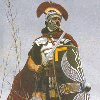
Roman Centurions
CBUB Wins: 0
CBUB Losses: 1
CBUB Ties: 0
Win Percentage: 0%
Added by: CrinosVegeta
Read more about Roman Centurions at: Wikipedia
Official Site: Public Domain
A centurion ( ; ), also hekatontarch (ἑκατόνταρχος) in Greek sources, or, in Byzantine times, kentarch (κένταρχος) was a professional officer of the Roman army after the Marian reforms of 107 BC. Most centurions commanded 83 men despite the commonly assumed 100, but senior centurions commanded cohort, or took senior staff roles in their legion.
Centuries, or Centuriae, means tribe or company . Theoretically, this word traces its roots to centum which is Latin for one-hundred .
In the Roman infantry, centurions initially commanded a centuria or "century". Centuries, or centuriae, developed from the Roman tribal system under the Servian reforms and could contain anywhere from 80 to 100 men. This became 100, at full strength, under the Marian reforms. Later, generals and Caesars further manipulated these numbers with double and half-strength units. Gaius Julius Caesar, for instance, made the first century double strength.
During the Imperial era centurions gradually rose in seniority in their cohort, commanding centuries with higher precedence, until commanding the senior century and therefore the whole cohort. The very best centurions were then promoted to become centurions in the First Cohort, called Primi Ordines, commanding one of the ten centuries and also taking on a staff role. The most senior centurion of the legion was the Primus Pilus who commanded the first century. All centurions, however senior, had their own allocated century.
Images with a green border may be set as the character's main profile image (For images 200x200 or 300x300 pixels square).
CBUB Match Record:
| Result | Opponent | My Score | Their Score | |
|---|---|---|---|---|
| Loss | The Klingon Empire | 8 | to | 9 |
No Fantasy Draft Records Available


